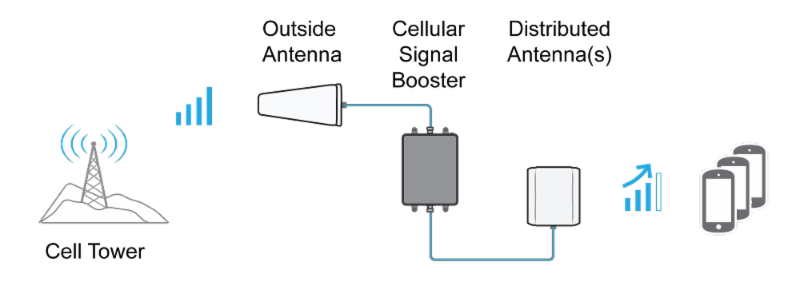Active DAS vs. Passive DAS (aka. Signal Booster)
Apr 18, 2017
SureCall Industrial and Commercial Cell Phone Signal Boosters are Passive Distributed Antenna Systems (Passive DAS). What is the difference between these and Active Distributed Antenna Systems (Active DAS)?
Passive DAS is a more economical alternative to Active DAS and the typical timeline is shorter than an Active DAS. |
How Signal Boosters (Passive DAS Systems) Work:
|
Rising Demand For Reliable Cellular Connectivity In Commercial Buildings.With the surging demand for constant connectivity, the need for reliable cellular service inside commercial buildings has grown dramatically. As we move towards a cord-free lifestyle, business communication is being conducted on cell phones more than ever before. SureCall signal boosters enhance internal communications with reliable in-building connectivity and constant up-time for voice, 4G LTE data, Wi-Fi, and public safety communications inside buildings up to 100,000 square feet and beyond. Learn more about SureCall's commercial-grade boosters.
|
The Performance Leader of Signal Boosters.SureCall is the multi-patented leader in signal booster technology, offering a large selection and high performing boosters available on the market today. SureCall signal boosters are designed for all types of buildings and applications, including: commercial, academic, municipal, government and hospitality. SureCall commercial-grade boosters increase in-building signal strength for all carriers in North America, including AT&T, Verizon, US Cellular, Sprint and T-Mobile.
|
Force5: Celluar Signal Booster for Large Buildings
|
Recent Case Studies:
|
|
Connect With Us!
At SignalBooster.com, we are always looking to connect with cellular carriers, government agencies, contractors, integrators, VAR's and solution providers. Read more about us, request DAS installation service, or simply reach out to us so we can help you and/or your customers stay connected with DAS (Distributed Antenna Systems).
|
Share this post
3 comments









I know that you absolutely need active DAS in some situations, but if you don’t passive DAS has to be an attractive alternative for any business that has issues getting a strong cell phone signal. The cost benefits and quick installation time are markedly different than active DAS.
I hope business owners either read these blogs or have good IT people who keep up on ways to increase their building’s cell phone signals. There seem to be different options between active DAS and passive DAS, then you have the factor of the cell phone booster added in. Hope people are doing their homework so they can maximize the power of their cell phones.
I couldn’t believe some of those figures for active DAS. Looks like a substantial savings if you install a passive system. Commercial outfits looking how to improve cell phone signal strength probably don’t have the extra money for an active system. However, what true advantages are there in putting in an active system? Seems like a bit of extravagant spending.